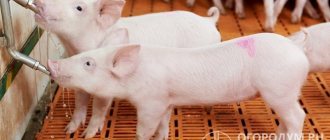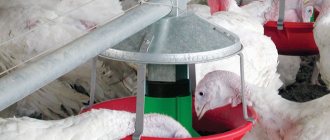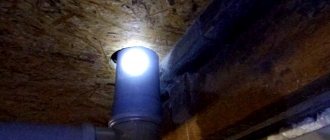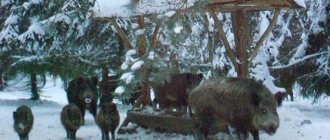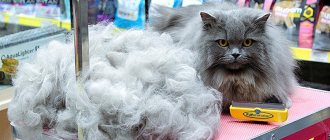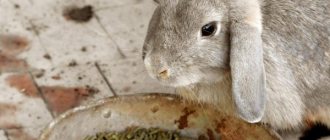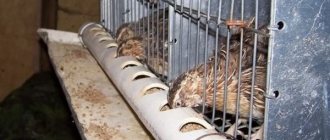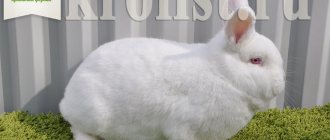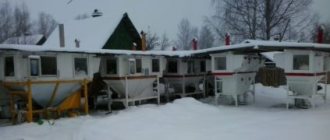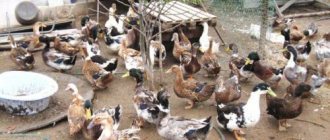Rabbits are extremely active and mobile animals. Therefore, using ordinary shallow bowls, plates and boxes as a feeder risks the fact that some of the food is constantly scattered throughout the cage, stuffed into the cracks of the floor, trampled into the dirt and bedding. In addition, such living creatures eat frequently, which is why it is necessary to constantly check the container for the presence of food. But when using a bunker feeder for rabbits, animal owners are able to solve both problems, significantly saving time in caring for animals, and reducing the consumption of feed supplies.
Hopper feeder
Requirements for feeders
Before purchasing devices, you need to take into account their indicators, which will help organize a rational feeding process:
- the correct volume of the feeder (should accommodate the daily portion of feed);
- ergonomics (convenient to pour food, easy to remove for cleaning and disinfection);
- safety for animals (high-quality material of construction, absence of sharp corners, notches);
- impossibility of getting animals, garbage, feces inside.
You can use different designs at the same time, matching them to the products.
Important points
Before you start making a homemade feeder, you need to take into account a number of rules to make it convenient for the rabbits to eat and for the owner to clean up:
- If the product is not made of metal (or galvanized), then it is necessary to immediately eliminate the risk that the animal will gnaw on the surface.
- The size of the feeder must be optimal for the amount of food that is intended for the animal per day. If the container is larger in size, then the rabbits will begin to climb into it and pollute the cage with food.
- It is quite important to pay attention to the fact that there are no small burrs or sharp corners along the edges, otherwise the rabbit will easily get a splinter or get hurt.
- It is necessary to provide in advance so that the container can be securely fixed to the wall or to the floor, otherwise the rabbits will easily turn it over.
- It is necessary to accurately calculate the size of the feeder, taking into account how many animals will feed in it.
- The container must be easy to clean. In this case, metal structures are best suited.
Main types of feeders
- Bunker models. A practical container that is suitable for dry granulate and grain. In essence, this is an automatic feeder in which food is supplied automatically as it is eaten. The animals have unhindered access to the dishes, making it convenient to eat from them.
There is no need to check that the tank is full, because its volume is designed to last for a long time. The designs are ergonomic - easy to fill and clean. You can buy it or make it yourself using galvanized steel using special drawings. - Nursery devices. A manger or hay barn for rabbits is a popular design that is made from wood or metal. Used for hay or grass - prevents their scattering. Senniks can be placed both inside the rabbitry and from the outside. It is not advisable to attach the sennik to the cage door so that the baby rabbits cannot get in and be injured.
- In the form of cups. Such dishes are suitable for feeding juicy and dry foods. Stores offer ceramic or plastic cup designs. Due to the fact that rabbits often turn them over, they are not practical enough in practice. Bowls can be easily made independently from scrap materials (tin cans, plastic bottles, concrete pours).
- Grooved. Chutes are used for all types of products. Animals have unimpeded access to such reservoirs, especially during collective breeding. Minus - they easily turn over, feces, bedding, and dirt can get into them.
- Models for root crops. Cup containers are best suited for feeding succulent feed, but trough options can also be used.
- Universal devices. This group includes bowls, gutters, and self-made models. The advantage of this variation is the ability to feed different types of feed at the same time.
- Other models. There are different types of industrial feeding containers that differ in appearance, quality, and cost.
Device
The bunker feeder consists of two components:
a vertical tank in the form of a box with a rectangular cross-section or a round pipe - a bunker. A socket is welded onto the top of the pipe for ease of loading feed. For this purpose, the front wall of the box is made sloping outward. There is a narrow opening at the bottom of the hopper. The container can be equipped with a damper that regulates the amount of food spilled out. A lid is installed on top of the hopper to prevent rodents, insects from getting inside, and if the hopper has a neck that goes outside (easy to load), then also from precipitation. Due to the loose fit of the lid or the installation of ventilation holes protected by a mesh, ventilation of the internal space is ensured, which eliminates moisture condensation in the bin and grain rot. This is especially important during the cold period, when steam condenses intensively on the cooled walls;- dispensing chute or tray. Installed under the bunker. Grain spills into the tray from the hopper until there is a fairly large mound that blocks the hole. While eating the food, the rabbits open the hole and some grain is poured back into the tray. The bottom of the tray is made of fine mesh or many holes are drilled in it. This is necessary to drain condensate and sift out grain flour. In order to prevent feed from spilling out, the sides of the tray are folded (tin products) or equipped with slats.
The bunker feeder is suitable for the following feeds:
- grain mixtures;
- compound feed;
- various granular additives.
The diet of rabbits is not limited to this, so other feeders will be required:
- for root crops and mash: trough or cup feeders;
- for hay and forbs: nursery feeder (haybox).
Materials and tools for making feeders yourself
Making a device with your own hands is not difficult. You just need to stock up on materials for manufacturing and tools with which it will be convenient to make such structures. Before work, you will need diagrams of future products with dimensions.
| Materials | Tools |
| Wooden boards, plywood sheets Flat slate sheets PVC pipes (plastic) Sheet of metal (preferably stainless steel) Roll of wire Metal mesh of different sizes Plastic canister Plastic bottle | File Self-tapping screws (nails) Pliers Wire cutters Hammer Screwdriver Drill Tape measure Pencil Scissors Stationery knife Rivets Pliers File |
Valuable tips for building feeders at home
Before you start manufacturing bunker feeders for rabbits according to the drawings, you should take into account the following recommendations:
- all components of cage arrangement, including feeders, should be as convenient as possible in maintaining cleanliness and hygiene;
- if the feeder is made of thin materials that can be chewed by rabbits, then it is necessary to cover the edges of the feeder with tin for its longest service life;
- It is recommended to arrange the feeders so that the food is contaminated as little as possible (drill holes in the bottom of the feeder, or line the bottom with a fine grid);
- the volume of feeders must be no less than the daily feeding rate for rabbits, otherwise the animals will climb into them and mess up;
- Attachments of feeders to cages should be as strong as possible to prevent them from overturning.
The growth rate of rabbits directly depends on the quality of feeding.
A creative approach to breeding eared pets will make rabbit breeding a very interesting activity. If you build cages and feeders for rabbits with your own hands from scrap materials, you can save an impressive amount before starting a rabbit breeding business.
Food from a bottle
You can make a bunker feeder from a plastic bottle. But only the feed bunker itself is prepared from it. The tray needs a more durable material so that the animals do not gnaw it.
To make it you will need: tape measure, drill, screws, scissors. A plastic container for the hopper and a sheet of metal or profile for the tray.
Mark and cut out a tray pattern from a sheet of metal or profile. Its width should correspond to the width of the bottle neck. Assemble the tray and fasten the edges with self-tapping screws. Sand the edges and corners with sandpaper.
Take the bottle and cut its neck so that it fits snugly into the tray. Cut off the bottom, food will be placed there. Insert the resulting part into the tray with the neck down. For strength, secure it on both sides with self-tapping screws.
Make two holes in the top of the hopper and thread fasteners (wire, rope, plastic tie). Attach the structure to the cage door.
Why plastic pipes?
All owners of chickens, turkeys, quails, ducks and other poultry are faced with the problem of uniform feed distribution. It is unprofitable to devote a large area to the feeder, and in the bowl the food turns out to be unevenly distributed: hens and chicks randomly crowd each other, interfere with weaker individuals, and, in addition, trample on the feed.
The best shape for the product is a container that is long but narrow. This option takes up a small area and provides better access to food for chickens and quails. Previously, such containers were made of tin, but today there is a material that is more affordable and more consistent with the necessary requirements.
A bird feeder made from a plastic pipe has many advantages:
- the material is not afraid of moisture, so it is well suited for both food and water;
- plastic is hygienic - it does not promote the growth of bacteria and is not prone to mold;
- the initial “raw materials” – plastic pipes, have a more than affordable cost;
- the range of materials - wall thickness and diameter, cannot be described;
- making it yourself takes a minimum of time, does not require experience and allows you to build structures for both turkeys and rabbits, in accordance with the size of the latter.
The only disadvantages include less durability compared to particularly durable steel and cast iron products.
Dimensions
The volume of the bunker is calculated using the simple formula V = A * B * C, where:
- A is the daily feed requirement for one rabbit;
- B - number of pets;
- C is the number of days for which the feeder is designed.
The dimensions of the bunker are arranged so that it fits well into the cage and is located as rationally as possible. If the cell is to be divided in two, the bunker can act as a partition.
Sometimes it is made elongated and used as one of the outer walls. But with this design, there is no possibility of dismantling the feeder for repairs and cleaning of remnants of old food, and this is sometimes required.
Drawing of a bunker feeder
The dimensions of the tray are selected so that all rabbits have simultaneous access to food. Otherwise, strong individuals will constantly push aside the weak ones and they will get sick from malnutrition. The tray of the bunker feeder cannot have any length - the grain pours out of the tank over a limited distance.
Therefore, with a significant number of livestock, they install a battery of several devices or make a couple of holes in the bunker on opposite sides and equip it, respectively, with two trays.
